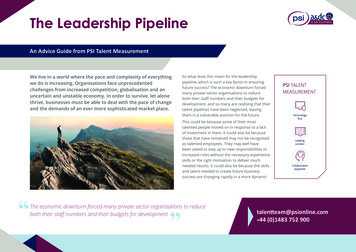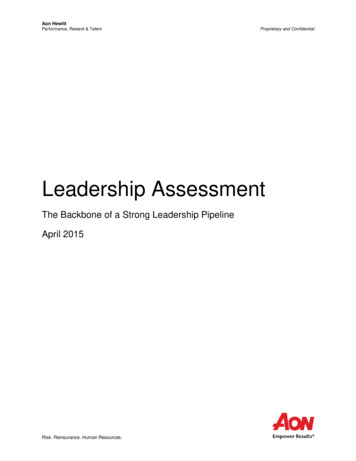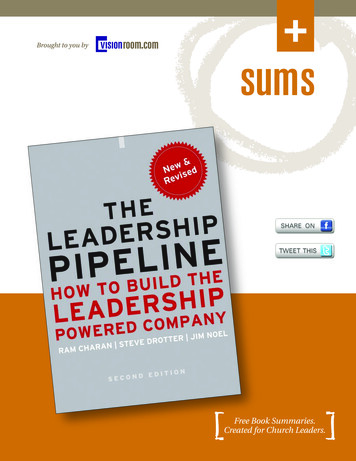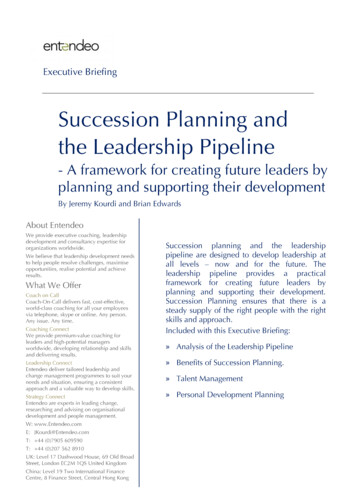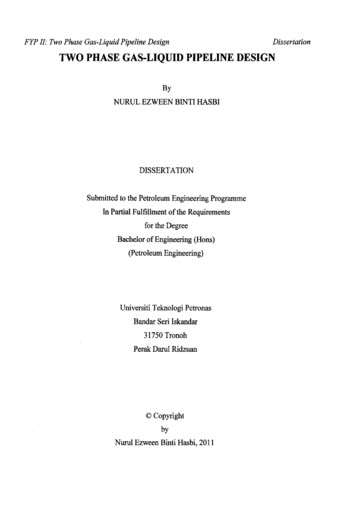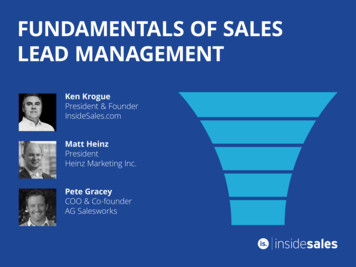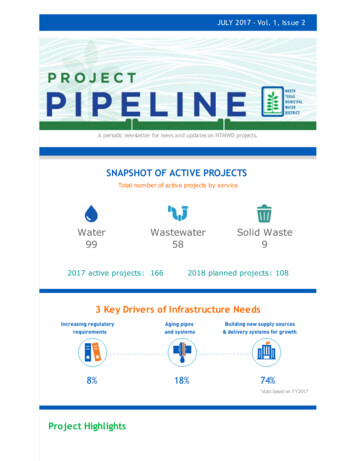
Transcription
Developing a Leadership PipelineHow to transform your top-to-bottom leadershipto boost organizational performance.Contrary to the phrase that someone is a “born leader,” expertise and experience are hard won and hardearned. It takes years of working in the trenches to gain the insights, knowledge and skills of a seasonedveteran, with most leaders needing to be developed along the way. The same holds true in healthcare,where employees at every level need to continually develop to reach their potential and, for some, tostep into leadership roles.It starts at the top with strong, effective leadership, which trickles down throughout the organization. Solidleadership at all levels sets the foundation for building a strong company culture and, ultimately, having anengaged workforce.As Eric Scharber, Principal at Simione Healthcare Consultants, points out, healthcare is, at its core, a peoplebusiness. “We’re not selling widgets or devices or something tangible,” says Scharber. “We are people takingcare of people. To do that well, you have to have an engaged workforce.” Scharber should know—he leads talentacquisition and employee retention efforts for the home care and hospice industry through Exact Recruiting,a Simione Talent Solution.Simione.com844.293.1530
In fact, leadership development at every level plays acritical role for home health and hospice organizations.Why? It’s not always possible to simply go out and“hire” new leaders when you need them. To thrive, yourorganization must focus on developing new leaders andcontinually investing in existing ones.Plus, there’s the whole “talent gap” issue. In the healthcareindustry, a huge chasm exists in the number of highlyseasoned leaders when compared to the demand inthe space. That gap is likely to widen with the growingdemand and heightened expectations among providers,patients, and payers.For example, according to the most recent NationalNursing Workforce Study, the average age of RegisteredNurses is 51. Other statistics predict that many of those 55years or older are planning to retire in five years. The result?A huge portion of the workforce will be exiting while a hugeinflux of new nurses will be entering it.“This creates a talent gap in leadership,” notes Scharber.“What organizations better be doing right now is developingtheir workforce from the top through the middle and evenwith the newbies. This will keep the organization thrivingand growing.”Of course, leadership development takes time, resources, andsustained effort. But when you focus on this, you create aleadership pipeline filled with outstanding employees readyto step up and move the organization forward. Think of itas top-to-bottom succession planning.Simione.com Developing a Leadership Pipeline“Companies are successful to the extentthat they have leaders at all levels of theorganization. Any institution that investsin the development of leaders at all levelsis going to get ahead of its competition.”-Noel TichyDirector of the Global Leadership ProgramUniversity of Michigan Business SchoolWhen it comes to cultivating an engaged workforce, it’sworth dissecting what successful companies do to retainstaff—especially in light of the healthcare industry’s highturnover rate. One of the biggest retention factors lies incompany culture—and the owner or CEO is the drivingforce. “Having a company culture that promotes staffengagement and gets people excited about working theregenerally yields greater job satisfaction,” notes Scharber.As you create this engaged workforce and start developingleaders at all levels, they’ll get behind your core valuesand help power your mission. “Good leadership translatesinto good company culture, which translates into goodorganizational results,” says Scharber, noting that as yourleadership abilities grow, both your outcomes and yourbottom-line performance will improve.2
So How Do You Transform Leadership fromAverage to Amazing?The first piece of building this leadership pipeline, says Scharber, is to put talent development at the topof your priority list. “This requires C-suite engagement. It can’t just be a human resources issue,” Scharberpoints out. “Senior leadership needs to develop their leaders at the top to then develop other leaders inlayers below.”To catapult your organization to higher levels of performance, Scharber offers these tips:1. Embrace the Talent Development TimelineHaving placed nearly 2,000 people over the last 15 years, Scharber observes an impatient mindset withinthe industry. “I’ve seen countless times where organizations hire somebody and then just three monthslater, say the person isn’t working out and start over with the hiring process.” Organizations often look forthe perfect candidate who checks all the boxes and can hit the ground running with no training. But that’susually not an option. More common? Organizations find someone who meets most of the criteria butneeds some training. That’s where talent development comes into play. “This is not a one- or two-monthscenario; this is a long-term process,” says Scharber, noting it might take 6-12 months before an employeeis where you need them to be. This means investing time and resources into developing your team everyday. If done properly, you will improve your team overall, as well as improve your ability to retain your staff.In a recent national survey of over 400 employees spanning three generations (Baby Boomers, GenerationX and Millennials), 70% of the respondents indicated that job-related training and development opportunitiesinfluenced their decision to stay at their job.2. Be Flexible in How You Manage PeopleDitch the one-size-fits-all management approach. Leaders must be flexible in how they manage peoplebased on their staff’s needs. Some people need to be challenged, while others need to be nurtured. Thiscan vary across generations, from Baby Boomers to Generation X to Millennials. Keep in mind that, by2025, nearly 75 percent of the workforce is going to be Millennials. How you treat them, manage them,and communicate with them will differ from the approach you use with older workers.Simione.com Developing a Leadership Pipeline3
3. Learn What Motivates StaffDiscovering what your employees’ goals are and what drives them can be as simple as having realconversations with them. “With your top-level leaders, especially the CEO position, half of the job is likebeing a Counselor-in-Chief trying to understand your people and what drives and motivates them,” saysScharber. While some people aim to climb the corporate ladder, not everyone wants to rise to the top.And that’s a good thing, notes Scharber. Why? “Your organization needs those worker bees and frontlinefolks.” Armed with these insights, you can manage employees differently.4. Help Staff Get to the Next LevelTo continue to develop, your team members might need help assessing their strengths and weaknesses.Even if they don’t aspire to higher-level roles, they still need to develop to their fullest potential. Helpemployees see where they struggle and put plans in place to transform those weaknesses into strengths.This might mean having some tough conversations, says Scharber, as you need to say, “Here’s where youare now, here’s where you want to be, and here’s a plan to navigate that delta.” Also, don’t forget to talkabout the positives by praising employees for the good work they’re doing in other areas.One final note: Scharber emphasizes that leadership development is never a completed project, from the C-suiteto the frontline staff. It all starts with asking yourself, “Am I a good leader?” Regardless of your role, you cantap into plenty of leadership resources to improve. You can find mentors, hire consultants, go to training, attendseminars, take online courses, and read books. “You just need to be willing to put in the effort to become a betterleader and continually challenge yourself.”“You don’t build a business. You build people, and people build the business.” – Zig ZiglarWhat Does It Mean to Be a Good Leader?The most important thing for good leaders in a people-driven service business, is someone who absolutely putspeople first and truly cares about their staff. Since the most important asset in your organization is your people,it makes sense to take care of them. A good leader treats staff right, develops them, and builds a great culture.In doing so, your people will take care of your patients, which will yield better outcomes.“I think the number one attribute of a really great leader is putting your staff first, doing everything you can togive them the opportunity to be successful,” says Eric Scharber, Principal at Simione Healthcare Consultants.Scharber leads talent acquisition and employee retention efforts for the home care and hospice industry throughSimione Healthcare Consultants and Exact Recruiting, a Simione Talent Solution.Another key leadership trait? Honing your communication abilities and adapting to changes. This is especiallyimportant when working with the newer generation who prefer different kinds of feedback and styles ofcommunication.Simione.com Developing a Leadership Pipeline4
A good leader also invests in staff, spending time with them (and real money on them), while also giving themopportunities to “work above their pay grade” to make themselves a better employee than they were whenthey were initially hired.Of course, good leadership requires transparency and honesty. When you let staff know what’s going on,what business decisions are being made (and why), you build trust throughout the organization.All of these leadership traits go a long way in attracting—and keeping—top talent.What Top Talent Looksfor in an EmployerSimione Healthcare Consultants and ExactRecruiting have interviewed more than 70,000people, which allows consideration of a databaseto identify trends when it comes to attractingtop talent. In a nutshell, here’s what first-rateprospects look for in an employer:1.Is the company transparentand up-front with staff?2.Do opportunities exist to grow,shine, and rise through theorganization?3.Is the company respected byand involved in the community?4.Does the organization havedynamic leadership?Simione.com Developing a Leadership Pipeline5
How Talent Development Creates ValueWithin an OrganizationWhether your organization is for-profit or non-profit, you’re looking for the margins, and the value of talentdevelopment is evident here in several layers.First, you develop people so they can then execute on your organization’s mission in a very positive way.This ultimately reflects in your positive outcomes and your organization’s financial success.But there is a big push these days with industry consolidation, with a lot of mergers and acquisitions takingplace. If your organization is looking to sell, then consider this. The talent within your organization drives betternumbers, and that makes a difference when a potential buyer starts doing diligence for possible acquisition.The talent within your company is going to make the sheer number value of your company muchgreater—possibly a difference in millions.Therefore, if you’re thinking about selling down the road, focus on developing your leadership. Not only will youget the results you need now, but talent development will create more value from a numbers standpoint whenyou ultimately do sell.Eric ScharberPrincipalSimione Healthcare Consultantsand Exact Recruiting, a Simionetalent solutionExact Recruiting, a Simione Talent Solution, specializes in post-acutecare, offering the largest network of home care and hospice professionalsthrough recruiting, executive search, non-executive search, interimmanagement, and advisory services for employee retention andsatisfaction.Simione Healthcare Consultants provides business solutions for homehealth and hospice with a diverse group of experts in clinical operations,finance, compliance, sales and marketing, cost reporting, informationtechnology, talent management, data analytics, and mergers andacquisitions. Our team supports performance improvement across thehealthcare continuum, engaging agencies, hospitals and health networksto enhance quality, reduce cost and minimize risk.To start the conversation and move your integration goals forward,call 844.293.1530.Simione.com Developing a Leadership Pipeline6
Developing a Leadership Pipeline How to transform your top-to-bottom leadership to boost organizational performance. Contrary to the phrase that someone is a “born leader,” expertise and experience are hard won and hard earned. It takes years of working in the trenches
